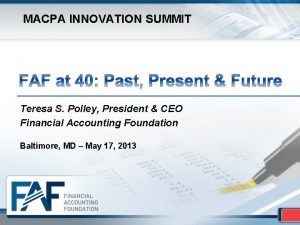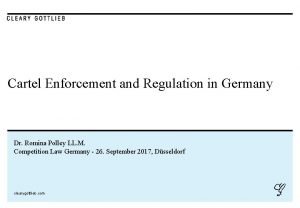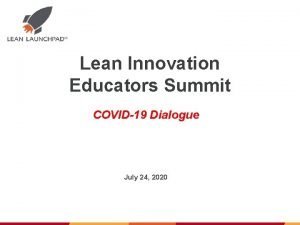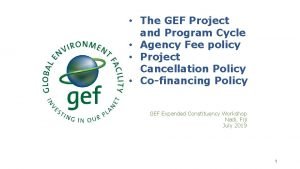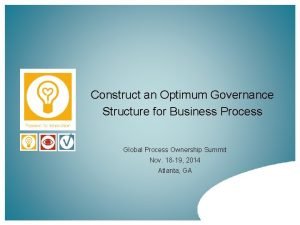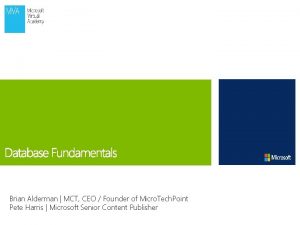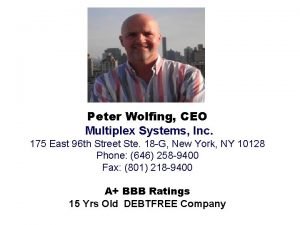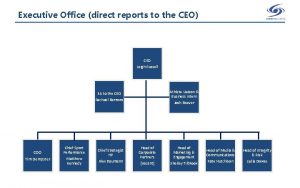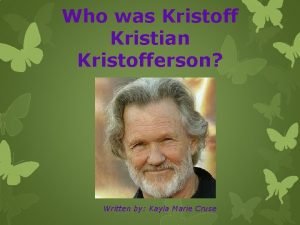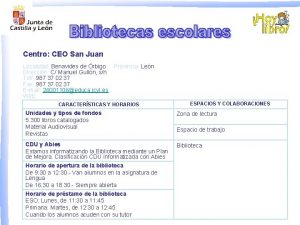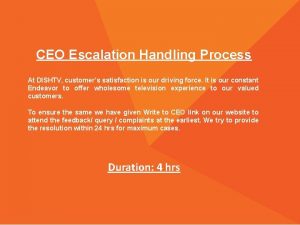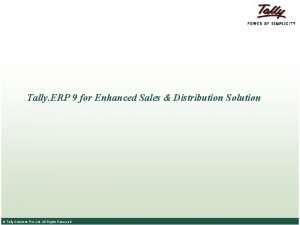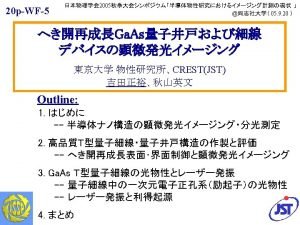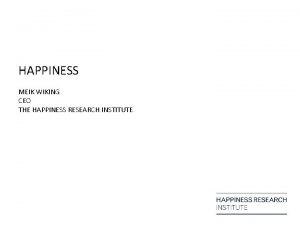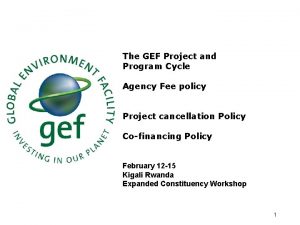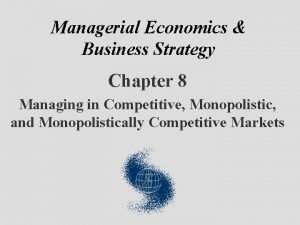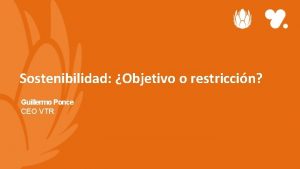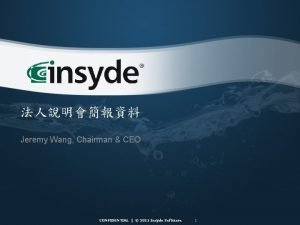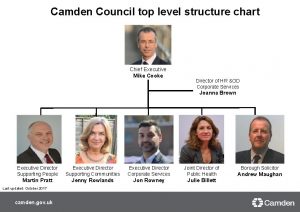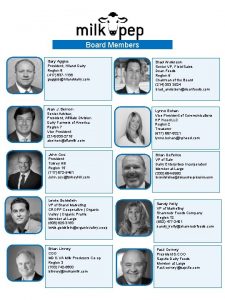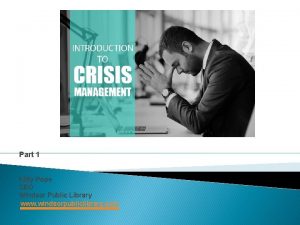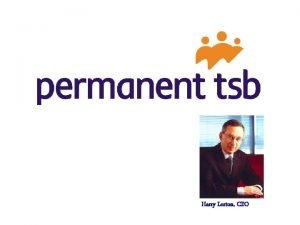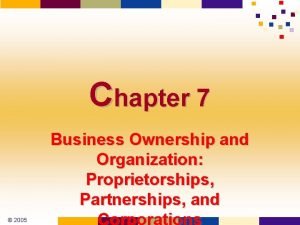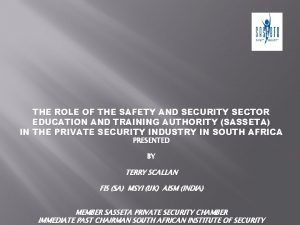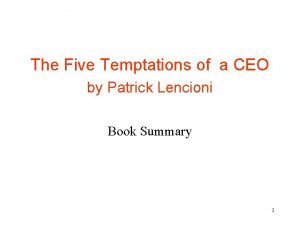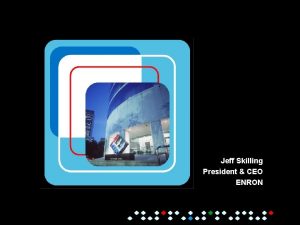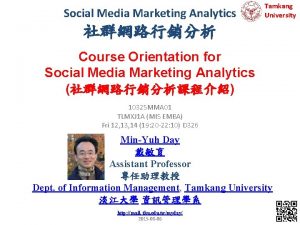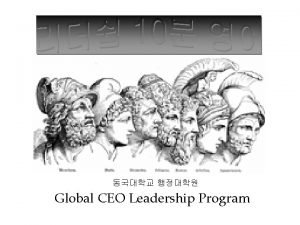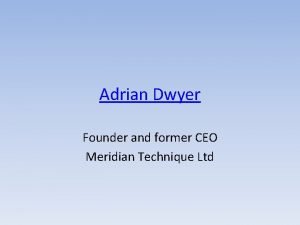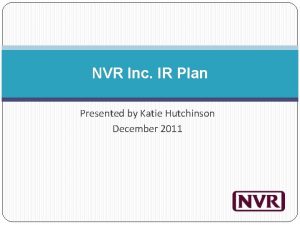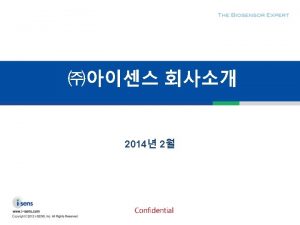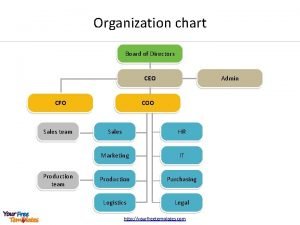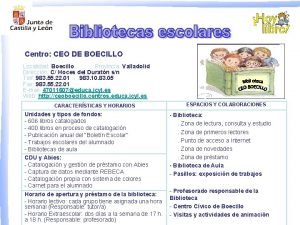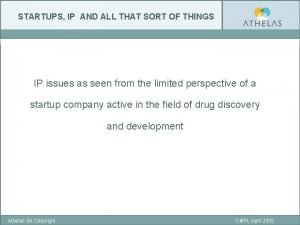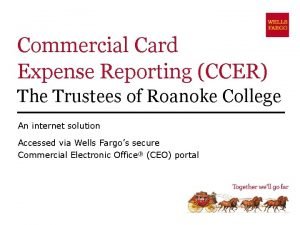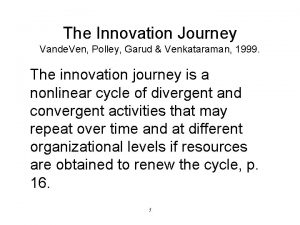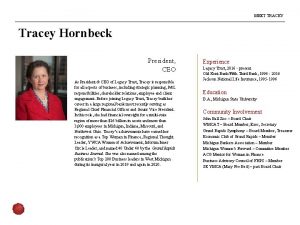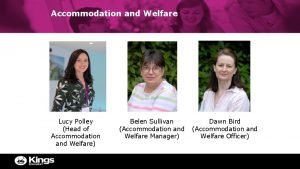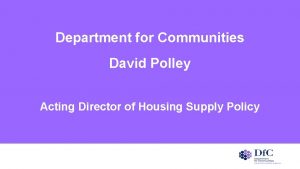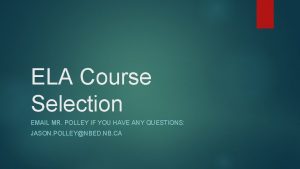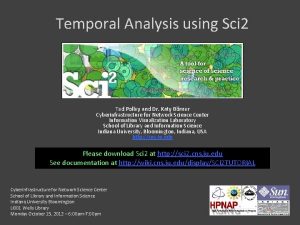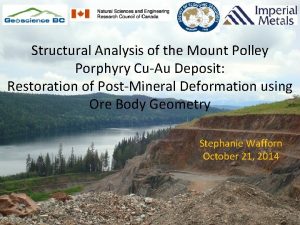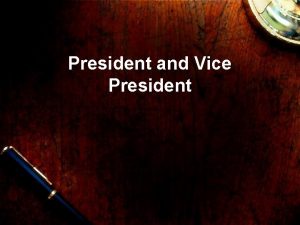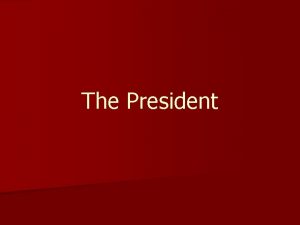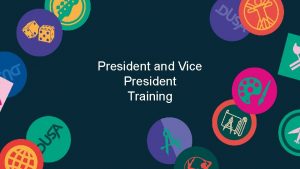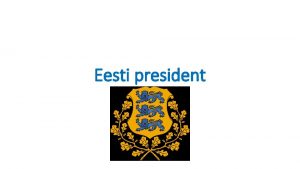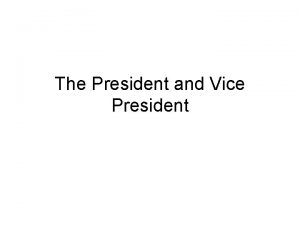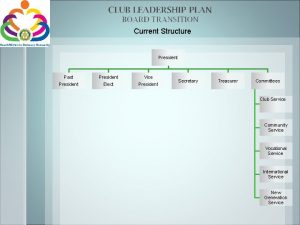MACPA INNOVATION SUMMIT Teresa S Polley President CEO






















































- Slides: 54

MACPA INNOVATION SUMMIT Teresa S. Polley, President & CEO Financial Accounting Foundation Baltimore, MD – May 17, 2013

The Definition of an Accountant Someone who solves a problem you didn’t know you had in a way you don’t understand 2

Program Agenda § Past – A (Very) Brief History of Standard-Setting § Present – An Overview of FAF/FASB/GASB § Future – Challenges & Opportunities - Changing leadership - Diverse stakeholder needs - International convergence - Private companies - Other strategic challenges 3

New Logos 4

New Website 5

Financial Accounting Foundation Standard Setting: A (Very) Brief History 6

Accounting Standards & Capital Markets Global markets depend on constant flow of reliable, comparable financial data Investors and taxpayers demand relevant, reliable, clear, consistent and comparable data to make informed decisions High-quality accounting standards and financial reporting play a role 7

A Brief History of Standard Setting 1933 – Securities Act of 1933 establishes SEC 1938 – Committee on Accounting Procedure (CAP) American Institute of Accountants 1959 – Accounting Principles Board (APB) – American Institute of Certified Public Accountants 1972 – SEC and AICPA create Wheat Committee 8

A Brief History of Standard Setting 1972 – Wheat Committee recommends creation of Financial Accounting Foundation (FAF) 1972 – FAF recognized as standard-setting authority 1973 – FAF establishes Financial Accounting Standards Board (FASB) 1984 – FAF establishes Governmental Accounting Standards Board (GASB) 9

Financial Accounting Foundation FAF, FASB, GASB: An Overview 10

FAF Mission To establish and improve financial accounting and reporting standards, fostering financial reporting that provides decisionuseful information to investors and other users of financial reports Accomplished through a comprehensive and independent standard-setting process that encourages broad participation, objectively considers all stakeholder views, and is subject to appropriate oversight and accountability 11

FAF Corporate Structure Delaware Corporation Incorporated 1972 FAF Not-for-profit 501(c)(3) Files IRS Form 990 12

FAF Trustees—Leadership Promote & protect independenc e & integrity of standardsetting Oversee & hold accountable standardsetting boards’ due process Stewardship in carrying out organization’ s mission 13

FAF Board of Trustees 14 -18 Trustees Business, professional, and govt. experience - 3 Government Officials - Remainder are “at-large” - Single 5 -year term - Varied backgrounds - users, preparers, government preparers, auditors, academics - Large market and middle-market experience 14

FAF Board Committees Appointments & Evaluations Audit & Compliance Executive Finance & Compensation Standard-Setting Process Oversight Private Company Review 15

FAF Financial Highlights – 2012 $53. 2 million in net op revenue and investment income $29. 8 m $13. 2 m • FASB accounting support fees (pursuant to Sarbanes Oxley) • FAF publication and subscription sales • GASB accounting support fees (pursuant to Dodd Frank) $8. 5 m $1. 7 m • Investment Income 16

Standard-Setting Boards Sets standards for public and private companies and not-for-profits Established in 1973 Sets standards for state and local governments Established in 1984 17

FAF FASB GASB Relationship FAF Oversight Standard Setting FASB GASB Standard Setting FAF Support 18

FASB-GASB Organization FASB & GASB similarly organized, but… Key differences: FASB § Full-time Board | 73 staff § SEC oversight GASB § Part-time Board, full-time Chair | 22 staff 19

Advisory Councils Financial Accounting Standards Advisory Council Governmental Accounting Standards Advisory Council Consult on: § Major technical issues § Technical agenda & project priority § Strategic matters (for example, private company issues) Membership: § Includes execs of major public companies, auditing firms, investment firms, government agencies, trade associations 20

Emerging Issues Task Force Mission: assist FASB through the timely identification, discussion, and resolution of financial accounting issues within the framework of existing authoritative literature Chaired by FASB Technical Director Observers (Fin. REC, SEC, IFRIC) Agenda established by FASB Members from public cos. , investment firms, accounting firms 21

Private Company Council New - Established in 2012 Identifies and votes on proposed modifications to existing GAAP for private companies based on criteria agreed on with FASB § Recommendations subject to FASB process Members from small & large private cos. , acct. firms, lenders, etc. 22

Other FASB Advisory Groups IAC | Investors Advisory Committee NAC | Not-for-Profit Advisory Committee SBAC | Small Business Advisory Committee 23

Financial Accounting Foundation Challenges and Opportunities 24

FAF Challenges and Opportunities New FASB and GASB chairs International Issues Private cos. State & local govts. 25

Financial Accounting Foundation New Chairs: FASB & GASB 26

New FASB and GASB Chairs A “first” in FAF/FASB/GASB history― Both Board chairs to begin new terms together 27

New FASB Chair Russell G. Golden § Seventh FASB chair § Term begins July 1, 2013 § Appointed to the FASB in 2010 § Joined FASB staff in 2004 § Former partner at Deloitte & Touche LLP, National Offices 28

New GASB Chair David A. Vaudt § Fourth GASB chair § 7 -year term begins July 1, 2013 § Iowa Auditor of State since 2003 (elected position) § KPMG for 25 years - 13 years as a partner. - Specialized in government services practice 29

Financial Accounting Foundation Private Company Issues 30

The Challenge Globalization Comparability Complexity User needs 31

Improving GAAP for Private Companies Single U. S. GAAP with exceptions and modifications for private companies Enhancing User Relevance Reducing unnecessary cost and complexity Two Key Vehicles § Private Company Council (PCC) § Private Company Decision-Making Framework (PCDMF) 32

Private Company Council Established by FAF on May 30, 2012; overseen by FAF Independent chair, sets own agenda Identifies, deliberates & votes on proposed modifications to existing U. S. GAAP for private companies § Based on agreed-on criteria w/FASB (PCDMF) § Subject to FASB endorsement and public due process Primary private company advisory body to FASB on active FASB projects 33

PC Decision-Making Framework Not intended to be entirely new conceptual framework Intended to facilitate decisions and drive consistency Fundamental approach retains & improves information relevant to typical users Seeks to reduce cost & complexity where appropriate, but not in a way that adversely affects reporting of relevant information 34

PCC Action – May 7 Tentative decisions in the following areas: § Intangible assets § Goodwill § Interest rate swaps 35

PCC vs. AICPA SMEs Project AICPA Framework: Self-contained, non-GAAP standards (blend of accrual income tax and other traditional accounting methods) PCC/FASB: A better cost-benefit balance within GAAP for private companies thru appropriate exceptions and modifications 19

Financial Accounting Foundation State & Local Governments 37

GASB Unique Considerations § Unique characteristics to consider - State & Local Government Environment - User groups - No direct SEC relationship - No international convergence goal; however, relationship with the IPSASB does exist § Goal is to consider convergence where appropriate - Board/staffing 38

S&L Government Environment § 50 sovereign states, Native American tribes, and U. S. territories § More than 89, 000 units of local government § Sovereigns' authority to set standards delegated to the GASB with FAF oversight in 1984 agreement § Broad array of financial statement users with different needs 39

GASB Scope & Agenda-Setting Process Proposal to revise the agenda-setting process for the GASB § Issued February 2013; 39 comment letters received § Assists FAF Trustees in assessing scope of GASB’s standard-setting activity § Based proposal on discussions with GASB leaders, staff and stakeholders § Considered independent academic study § Oversight committee & GASB develop plan 40

Financial Accounting Foundation International Convergence 41

Convergence - Successes Since 2002, the FASB and the IASB have substantially improved and converged standards in the following areas: Business combinations Noncontrolling interests Fair value measurements Borrowing costs Segment reporting Stock compensation Nonmonetary exchanges 42

Remaining Joint Projects Revenue Recognition Leasing Financial Instruments Insurance 43

Convergence―Challenges Different starting points Cultural differences Cannot be achieved by standard setting alone 44

SEC Decision July 13, 2012 SEC staff issues final paper on possible incorporation of IFRS into U. S. GAAP § No recommendation on how U. S. should proceed § Describes positive aspects of IFRS § Identifies continuing concerns ü Costs of transition ü Inconsistent application ü Permanent funding mechanism 45

What It Means to the U. S. § FASB’s mission is to ensure capital providers benefit from the highest quality standards that can be consistently applied, interpreted and enforced to provide best financial reporting § FASB will focus on continuing to improve U. S. GAAP § FASB will continue to work with national, regional and international standard setters to develop more comparable global accounting standards 46

Accounting Standards Advisory Forum § Established by the IFRS Foundation to advise the IASB § Consists of national standard-setters, including FASB § Role: to provide technical advice and feedback to the IASB § IFRS Foundation Trustees to review membership every 2 years 47

Accounting Standards Advisory Forum Opportunities for FASB: • Represent U. S. interests in IASB standard setting • Enhance relationships with other standard setters • Continue process of converging U. S. GAAP and IFRS Mutual commitments consistent with FAF Trustees’ view of long-range goal of converging global accounting standards 48

Financial Accounting Foundation Key Strategic Issues 49

Strategic Issues – FAF/FASB/GASB Relevance How do we remain relevant to our stakeholders in a fastchanging environment? Complexity How do we reduce complexity in an increasingly complex world? 50

Strategic Issues – FAF/FASB/GASB Uncertainty How do we chart the proper course – domestically and internationally – amid significant uncertainty? Engagement How do we continue to constructively engage our stakeholders? 51

Strategic Issues – FAF/FASB/GASB Relevance Complexity Uncertainty Engagement 52

Talk to Us! www. Accounting. Foundation. org www. fasb. org www. gasb. org tspolley@f-a-f. org twitter. com/FAFNorwalk 53

Financial Accounting Foundation Questions 54
 Teresa polley
Teresa polley Romina polley
Romina polley Marie polley social prescribing
Marie polley social prescribing Ted polley
Ted polley Ducks unlimited president
Ducks unlimited president Lean innovation educators summit
Lean innovation educators summit Disruptive and radical innovation
Disruptive and radical innovation Mysite.socccd
Mysite.socccd Ceo approval
Ceo approval Ceo, cfo, coo hierarchy
Ceo, cfo, coo hierarchy Mct ceo
Mct ceo Peter wolfing
Peter wolfing Ceo direct reports
Ceo direct reports Kelly marie kristofferson
Kelly marie kristofferson Starb ucks
Starb ucks Ceo san juan
Ceo san juan Dish tv complaint email id ceo
Dish tv complaint email id ceo Riscv international ceo calista
Riscv international ceo calista Ceo ipswich city council
Ceo ipswich city council Tally ceo dashboard
Tally ceo dashboard Ceo
Ceo Where is happiness
Where is happiness Mary's meals ceo salary
Mary's meals ceo salary Ceo approval
Ceo approval Www.sus.org
Www.sus.org The ceo of a major automaker overheard
The ceo of a major automaker overheard Feo ceo
Feo ceo Ceo netweavers
Ceo netweavers Ceo vtr
Ceo vtr Insyde ceo
Insyde ceo Chief executive camden council
Chief executive camden council Boardroom metrics ceo evaluation
Boardroom metrics ceo evaluation Gary aggus
Gary aggus Kitty pope
Kitty pope Harry lorton
Harry lorton Movianto spain
Movianto spain Ceo to worker pay ratio
Ceo to worker pay ratio 21 setas
21 setas Jesus ceo book
Jesus ceo book Fat herbalife ceo
Fat herbalife ceo 5 temptations of a ceo summary
5 temptations of a ceo summary Ceo enron
Ceo enron Ceo alliander
Ceo alliander Ceo coo
Ceo coo Heroic public speaking
Heroic public speaking Ceo meridian
Ceo meridian Nvr investor presentation
Nvr investor presentation Rand water ceo salary
Rand water ceo salary Cto ceo cmo
Cto ceo cmo Ceo coo cfo
Ceo coo cfo Kpogcl ceo
Kpogcl ceo Lumos nigeria ceo
Lumos nigeria ceo Ceo boecillo
Ceo boecillo Athelas.com ceo
Athelas.com ceo 1-800-932-0036
1-800-932-0036
